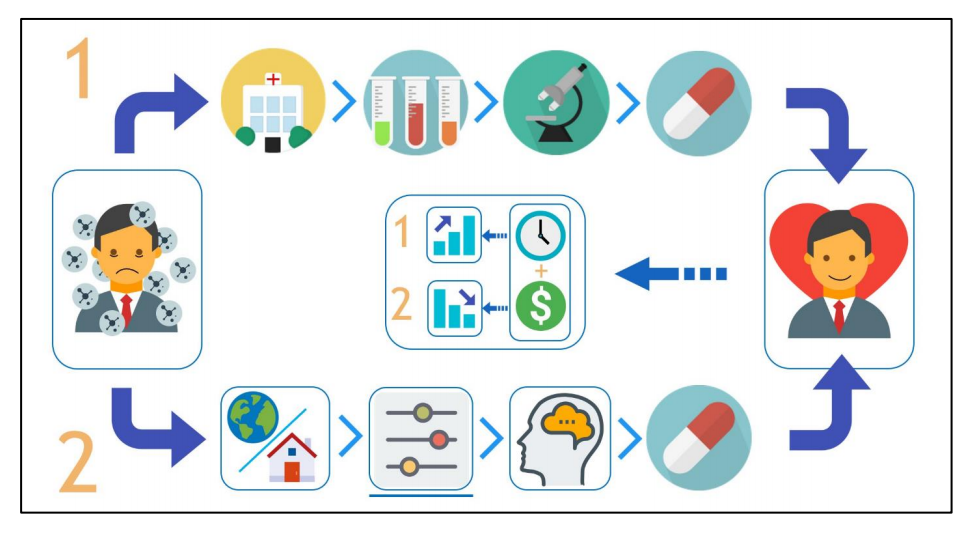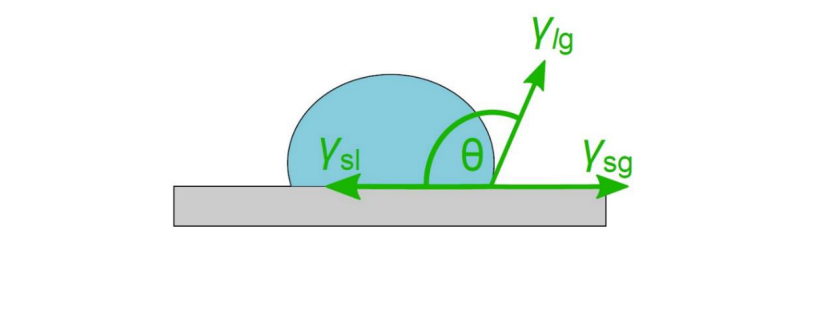In the recently published ‘Portable Microfluidic Platform Employing Young-Laplace Pumping for Multiplexed Lab-on-a-Chip Applications’ author Leonard Mahlberg discusses the relevance of lab-on-a-chip devices today in numerous applications, but mainly medicine. These devices allow for faster and more affordable lab analysis, but Mahlberg points out that there is a need for streamlining and more accuracy in microfluidic systems. Their work is centered around a platform employing surface tension-induced pumping founded on Young-Laplace pressure. This mode means that transport can not only be modified easily but fluids move without the requirement for external modules.
Microfluidics, whether digital microfluidics (DMF) or continuous-flow microfluidics (CFM), offer the following benefits:
- Portability
- Ease-of-use
- Low sample consumption
- Fast reaction times

Graphical illustration of a comparison between a common medicinal treatment process for a sick patient (1) and a treatment process using a microfluidic device (2), showing the possible advantages of reduced time, energy and money consumption of MF devices.
Mahlberg mentions that microfluidics is in a ‘unique position,’ mainly due to the doors they open for medicine as well as biology and environmental analysis. Hydrophobic surfaces can be created via several different techniques, to include lithography, spray coating, spin coating, dip coating, and more—while hydrophilic areas are made through ‘direct or indirect approaches.’ Wettabilities allow for surface energy traps (SETs), resulting in droplet array fabrication, along with channels and other patterns.

Illustration of different droplet contact angles on (super)hydrophobic, hydrophobic, hydrophilic, and (super)hydrophilic classified surfaces
“One can perform analysis, extraction, or splitting operations when using SETs. An example of such a microarray with different wetting capabilities can be found in nature on Stenocara gracilipes in the Namib Desert,” explains Mahlberg. “This species of beetles possesses patterned hydrophilic bumps/channels surrounded by hydrophobic areas located on its wings and its back, allowing it to collect water in the surrounding air, which rolls down its wings and leads to its mouth.”
Digital microfluidics allows mixing and manipulating of droplets, through:
- Magnetic actuation
- Dielectrophoresis
- (super)hydrophilic- (super)hydrophobic patterned surfaces and electrowetting-on-dielectric (EWOD)

Comparison of different surface structures and droplet wetting behaviors; a: CA of a water droplet sitting on a flat surface (LV = LG, SV = SG); b: Illustration of the Wenzel State with a droplet wetting the entire surface it is sitting on; c: Illustration of the Cassie/Baxter where air pockets are enclosed between the droplet and the surface it is sitting on.
CFM devices are ‘more prominent,’ allowing for a focus on analysis of individual droplets, devices centered around fluid confinement through channels with rigid walls. This category of device can be used in detecting virus, sorting cells, and analyzing DNA, along with being used in energy applications for creating fuel cells, CO2 conversion, and more. MF devices can also be used in material sciences for synthesizing polymer foam, sorting nanoparticles, and more.
“When observing the behavior of liquids in such sub-millimeter scaled channels, one is able to notice different characteristics when comparing it to macroscale behavior,” explains Mahlberg. “This is due to the significant difference in liquid surface-to-volume ratios present in MF devices.”
Passive pumping of droplets occurs as a differential pressure is present—defined by Laplace pressure and determined by the Young-Laplace equation.
“Surface microfluidics presents several advantages when compared to enclosed MF-devices, including simple washing due to its open structure, environmental accessibility, clear optical path, reduced sample loss, high and reproducible flowrate, compatibility with biological experiments (depending on surface material) and monolithic construction,” stated Mahlberg. “Using micromachining techniques, such as laser micromachining, SETs can be machined onto superhydrophobic surfaces in any desired design.”
With the spin-coating procedure, reproducible substrates could be fabricated, offering an improved transparency characteristic. A ‘flexible and adaptable’ 3D printed platform was developed for liquid distribution, meant to be used with future LoC applications, along with improving user interaction.
After a systematic study on varying NaBH4 concentrations had been conducted, a 300 mM concentration was shown to result in both AgNP and AgNC synthesis in correlation with different total pumping time. These results serve as proof of concept that the ability to control flowrate opens the possibility to perform various LoC applications that employ reactions that rely on different reaction times.
“This developed proof of concept protocol could therefore be upscaled for multiplexed synthesis approaches, as other multiplexed reaction concepts have been presented for future potential applications,” concluded Mahlberg. “In particular, this flexible multiplexed microfluidic platform could be utilized for the development of a portable and cost-effective PoC device that is able to perform simultaneous multiplexed bioimmunoassays for pathogen detection in substances like blood-based on sandwich-ELISA.
“The creation of such a PoC device is of significant value for the field of medicine and society overall, as patients could use it to test their blood independently from home at any time, without the need to visit and consult a doctor. Such a PoC device would help patients to save time, energy and money, which could greatly benefit their treatment and help improve their lives.”
Microfluidics have been connected with 3D printing in many research studies lately, especially as other platforms have expanded, bioprinting continues to progress, and there is a growing focus on miniaturization. What do you think of this news? Let us know your thoughts! Join the discussion of this and other 3D printing topics at 3DPrintBoard.com.

Discrete sessile water droplets sitting on a hydrophobic surface, colored with food dye, courtesy of Bachus et al.
Subscribe to Our Email Newsletter
Stay up-to-date on all the latest news from the 3D printing industry and receive information and offers from third party vendors.
You May Also Like
Gorilla Sports GE’s First 3D Printed Titanium Cast
How do you help a gorilla with a broken arm? Sounds like the start of a bad joke a zookeeper might tell, but it’s an actual dilemma recently faced by...
Nylon 3D Printed Parts Made More Functional with Coatings & Colors
Parts 3D printed from polyamide (PA, Nylon) 12 using powder bed fusion (PBF) are a mainstay in the additive manufacturing (AM) industry. While post-finishing processes have improved the porosity of...
$25M to Back Sintavia’s Largest Expansion of Metal 3D Printing Capacity Since 2019
Sintavia, the digital manufacturing company specializing in mission-critical parts for strategic sectors, announced a $25 million investment to increase its production capacity, the largest expansion to its operations since 2019....
Velo3D Initiates Public Offering in a Bid to Strengthen Financial Foundations and Drive Future Growth
Velo3D (NYSE: VLD) has been among a number of publicly traded 3D printing firms that have attempted to weather the current macroeconomic climate. After posting a challenging financial report for 2023,...































